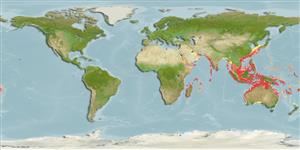Classification / Names
Common names from other countries
Main reference
Size / Weight / Age
Max length : 60.0 cm TL male/unsexed; (Ref. 2334); common length : 30.0 cm TL male/unsexed; (Ref. 2334)
Environment
Marine; reef-associated; amphidromous (Ref. 51243); depth range 20 - 140 m (Ref. 11441)
Climate / Range
Tropical, preferred 27°C (Ref. 107945); 40°N - 40°S, 26°E - 170°W
Distribution
Indo-West Pacific: east coast of Africa (without verified records from the Red Sea) to Sri Lanka and farther eastward to the Gulf of Thailand, north to Japan and south to Australia.
Countries | FAO areas | Ecosystems | Occurrences | Introductions
Short description
IUCN Red List Status (Ref. 115185)
Threat to humans
Harmless
Human uses
Fisheries: commercial; gamefish: yes
More information
ReferencesAquacultureAquaculture profileStrainsGeneticsAllele frequenciesHeritabilityDiseasesProcessingMass conversion
Tools
Special reports
Download XML
Internet sources
Estimates of some properties based on models
Phylogenetic diversity index
PD50 = 0.5000 many relatives (e.g. carps) 0.5 - 2.0 few relatives (e.g. lungfishes)
Trophic Level
3.9 ±0.52 se; Based on food items.
Resilience
High, minimum population doubling time less than 15 months (K=0.68)
Vulnerability
Low to moderate vulnerability (25 of 100)
Price category
